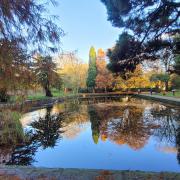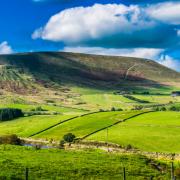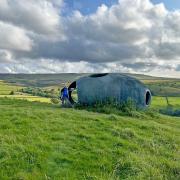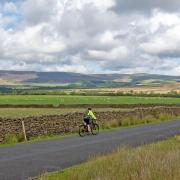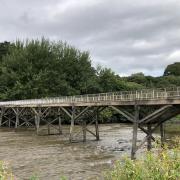Discover Worsley and learn how the Bridgewater Canal fuelled the Industrial Revolution. Words by Suzanne Hindle
Welcome to the birthplace of the 18th century transport revolution, the site of the UKs first commercial canal, after which all other canal systems followed, and the village where Opera Singer Russell Watson and Footballer’s David Beckham and Ryan Giggs once lived!
Marriott Hotel
Worsley – means the cleared place which was cultivated. Until 1450 it had a variety of spellings including: Workesley/Whurkedeleye.
We are standing in what were farm buildings, on the 200 acre former Worsley Hall Farm owned originally by the third Duke of Bridgewater, Francis Egerton. The farm was later altered in the 1840s and updated by the first Earl of Ellesmere by the architect Edward Blore who was responsible for the completion of Buckingham Palace.
Worsley Old Hall
As you can see the building is now a pub. The Grade Two listed Worsley Old Hall is a two storey half timbered building dating back to 1550 made of wood, plaster and brick. It was originally built around three sides of a quadrangle and was said to be surrounded by a moat protected by a gate house. Inside there is still the original oak staircase and the remains in one wing of the simple panelled family rooms with the servants living in the other wing. And there are also a number of supposed secret trapdoor passageways leading underneath to other historic buildings within a six mile radius, presumably for escape.
In 1759 the Old Hall became the home for a while of John Gilbert and his family when he was the Duke of Bridgewater’s agent, looking after the Duke’s affairs, ensuring the estate was run smoothly. It is said that in the rooms below, the Duke and his agent John Gilbert planned to build the Bridgewater canal. And at the end of the 18th century the Duke’s famous engineer James Brindley, responsible for designing Barton Aqueduct, lodged here several times. So the industrial revolution began here.
St Marks Church
When he died the Duke was succeeded by the younger son of the Duke of Sutherland, in accordance with the Duke’s will he changed his name to Egerton. So in 1833 Lord Francis Egerton inherited the Canal Duke’s estates and in 1846 he was granted an Earldom and it was in this same year that this church was built from �20k donated by the Earl to build a church for the village. The site was originally called Cross Field, as it was at the junction here that a Traveller’s or Our Lady’s Cross once stood, a nearby road Crossfield Drive is named after this too. The church was designed by architect Sir George Gilbert Scott who also built the Albert Memorial in London. Scott described the building as “the best of my works of art”. It is built in a gothic style, you can see the pinnacles, pointed archways and quatrefoil detail.
The clock you can see was originally housed in a tower built in 1789, which stood in the centre of industrial works yard, now the village green. One day the Duke was visiting the works yard and noticed that the men were late back from their dinner break. He was told this was happening because they couldn’t hear the clock strike one because of the noise of the yard. The Duke promptly contacted a local Eccles clockmaker had the clock adjusted so that it struck 13. The clock still strikes 13. It was later installed in gatehouse to the New Hall and remained there until 1923, when the fourth Earl sold his estates he didn’t include the clock so this went to London and was stored in the cellars of Bridgewater House. Then is 1946, the fifth Earl gave clock as centenary gift to the church, it was altered to fit.
The Delph
Delph was originally the sandstone quarry for the area, for use in building material and for the gravestones in the churchyard.
The cottage in the Delph was the stone mason’s cottage and workshops, built of local ashlar stone between 1770 and 1807.
Here you can see the remains of the beginnings of the passageways into the underground canal system through which the Duke mined coal in the area. And it was here that John Gilbert’s famous inclined plane was used, through which boats were moved from one level to another carrying the coal and through which the underground canal was drained. The stop gate mechanism on the left, had a wooden weir which could be raised to enable a low head of water to build behind it. When the weir was lowered it provided a current of water which would have helped full mine boats float from the canal. The boats were very slim, with wooden slats inside which looked like ribs so the boats were called starvationers.
As we move along the canal you will notice its famous orange colour. This is caused by iron ore deposits which make the water orange, recently the council has used reed bed technology to try to filter the ore from the water.
It is here that the first modern commercial canal running independently of any river was completed. The first Canal Act was drawn up by the Duke’s agent John Gilbert and passed into law on March 23, 1759 reaching Manchester in 1765. A requirement of the Act tied the Duke to ensuring that he would guarantee to keep the price of coal cheap, to four pence per hundredweight for 40 years, a condition of the Act that I am sure the Duke often wished he hadn’t agreed to as he probably could have made more money if he hadn’t had this tie in. The Duke had a saying “a canal should have coal at its heels” a reference to making a canal profitable, and it was from this underground canal system and mines that he made his money. Moving goods from Worsley to Manchester through to Runcorn and the estuary at Liverpool then out to sea. The Duke also built vast warehouses at Castlefield and Liverpool to store the goods he transferred.
Worsley Green
This was site of Duke of Bridgewater’s work yard. It was a busy, dirty work place, with worksheds, the chimney to stove the foundary, nailmakers, boat builders, rope makers, carpenters, wheelwrights, sawpits, smithies and a large timber yard. The work yard powered the running of the mines, the transport of goods on the canal, the passenger boat service, the upkeep of the canal, and in 1893 the movement of goods via the Bridgewater Colleries railway line. John Gilbert sought workmen for their skills from all over the UK.
The Duke was a firm but considerate employer. Men were fined half a crown if they were late for work, but this money was used to build a row of new cottages in Walkden, for the miners which became known as Half-Crown Row.
All his employees had to contribute to the estate's sick club, which provided support and benefits when members were ill. And hard work was rewarded – records show bonuses of ale and food for those who carried out particularly exemplary heavy labour.
The houses that you see date from 1900s, some of people may have visited Chester, in the 1900s mock-Tudor buildings were popular.
Monument on the green.
This is what remains of the original 18th century chimney for the forge. It remained a works yard until 1903 and took several years to remove all the machinery.
The Boat House
This housed the Royal Barge – which was specially built for Queen Victoria’s visit in 1851. It was 45 feet long, ornamental, painted white with red and gold lining, drawn by two grey horses with liveried postilions. The Queen and Prince Albert and the Duke of Wellington, travelled from Partricroft railway station where they transferred to the Royal Barge to take them to here and the newly built Worsley new Hall, now demolished, as a guest of Earl of Ellesmere. The Queen commented “the boat glided along in a most noiseless and dreamlike manner”.
She also stayed 1857 for the opening of Art Treasures Exhibition at Old Trafford, but the launch was not used for that visit. The Royal Barge was used again in 1869 when Prince Edward and the Princess of Wales travelled from Worsley Old Hall to Old Trafford to open the Royal Agricultural Show. On this visit the Royal Barge was accompanied by a flotilla of rowers, from local rowing clubs who formed a guard of honour holding their oars vertically standing to attention. One boat slowly sank, the crew remaining gallantly at the salute as the boat went under, the Royal party are said to have smirked and found this amusing.
More recently the boat house has been converted into a house where the opera singer Russell Watson used to live.
The Packet House
The house was originally a series of three storied cottages built before 1769. The black and white work and the jettied section were added in 1845. It was from the steps here in 1769 that passenger transport developed on the canal. Passenger boats held up to 120 people, there were different prices depending where you sat in the boat, like first and second class for rail travel. They served coffee and wine on board. The packet steps here linked with the Packet Station at Castlefield, which, post 1830, linked to the railway station at Liverpool Road. It was also from here that paddle steamers were first tried on the canal in the 1790s, these were later used on the Hudson river in America.
The Nailmaker’s house/shop
This was built before 1725 originally as a house, then altered in 1789 to be used as a nailmaker’s shop. It became a reading room for villagers in 1844, this was a subscription library and also a meeting place. Then in the 20th century it served as a library, craft shop, art gallery and offices.
On the opposite bank in the 1800s was a large four storey warehouse like you would see at any quayside, with loading bays, massive wooden doors, cranes and pulleys
Worsley Court House
Previously the site of Worsley stocks, which were a form of punishment for petty crime where you would be humiliated by the village, the Court House was built in 1849, by the Earl of Ellesmere as a meeting place and site of The Court Leet until 1888. There were also social functions held, plays performed – the Earl of Ellesmere himself performed here – and there were a great many balls attended by the upper classes .
To book a tour or for more information contact Salford Tourist Information Centre on 0161 848 8601
Suzanne Hindle is a qualified Manchester Green Badge Tour Guide
To find out more about her Manchester walks go to www.amanchestertour.co.uk















